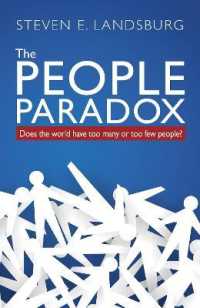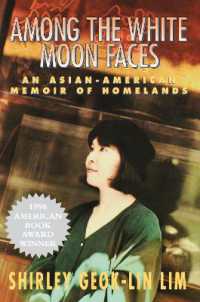- ホーム
- > 洋書
- > 英文書
- > Science / Mathematics
基本説明
Concentrates on the modern methods and technology used in the analysis and design of new steel superstructures for modern railway bridges.
Full Description
Perhaps the first book on this topic in more than 50 years, Design of Modern Steel Railway Bridges focuses not only on new steel superstructures but also outlines principles and methods that are useful for the maintenance and rehabilitation of existing steel railway bridges. It complements the recommended practices of the American Railway Engineering and Maintenance-of-way Association (AREMA), in particular Chapter 15-Steel Structures in AREMA's Manual for Railway Engineering (MRE). The book has been carefully designed to remain valid through many editions of the MRE.After covering the basics, the author examines the methods for analysis and design of modern steel railway bridges. He details the history of steel railway bridges in the development of transportation systems, discusses modern materials, and presents an extensive treatment of railway bridge loads and moving load analysis. He then outlines the design of steel structural members and connections in accordance with AREMA recommended practice, demonstrating the concepts with worked examples. Topics include:A history of iron and steel railway bridgesEngineering properties of structural steel typically used in modern steel railway bridge design and fabricationPlanning and preliminary designLoads and forces on railway superstructuresCriteria for the maximum effects from moving loads and their use in developing design live loadsDesign of axial and flexural membersCombinations of forces on steel railway superstructuresCopiously illustrated with more than 300 figures and charts, the book presents a clear picture of the importance of railway bridges in the national transportation system. A practical reference and learning tool, it provides a fundamental understanding of AREMA recommended practice that enables more effective design.
Contents
History and Development of Steel Railway BridgesIntroductionIron Railway BridgesSteel Railway BridgesDevelopment of Railway Bridge EngineeringBibliographySteel for Modern Railway Bridges IntroductionEngineering Properties of SteelTypes of Structural SteelStructural Steel for Railway BridgesStructural Steels Specified for Railway BridgesReferencesPlanning and Preliminary Design of Modern Railway BridgesIntroductionPlanning of Railway BridgesPreliminary Design of Steel Railway BridgesReferencesLoads and Forces on Steel Railway BridgesIntroductionDead LoadsRailway Live LoadsOther Steel Railway Bridge Design LoadsRailway SuperstructuresReferences Structural Analysis and Design of Steel Railway BridgesIntroductionStructural Analysis of Steel Railway SuperstructuresStructural Design of Steel Railway Superstructures ReferencesDesign of Axial Force Steel MembersIntroductionAxial Tension MembersAxial Compression MembersReferencesDesign of Flexural Steel MembersIntroductionStrength Design of Noncomposite Flexural MembersServiceability Design of Noncomposite Flexural MembersStrength Design of Steel and Concrete Composite Flexural MembersServiceability Design of Composite Flexural MembersReferencesDesign of Steel Members for Combined ForcesIntroductionBiaxial BendingUnsymmetrical Bending (Combined Bending and Torsion) Combined Axial Forces and Bending of MembersCombined Bending and Shear of PlatesReferencesDesign of Connections for Steel MembersIntroductionWelded ConnectionsBolted ConnectionsReferences Index








